Cats are known for their love of sleep, often dozing for up to 16 hours a day, and sometimes even more as they get older. As a cat owner, you’ve likely witnessed your feline friend in a variety of sleeping poses, some of which might seem quite peculiar. Have you ever wondered what it means when your cat curls up into a tight ball versus stretches out luxuriously by your side?
A cat’s sleep behavior is deeply rooted in their social nature and instincts. Despite their independent reputation, cats are social creatures capable of forming strong bonds with their human families and other pets. They often seek warmth while sleeping, which explains why they might choose to nap on or near you. Many cat parents even provide self-heating cat beds to cater to this preference, ensuring their furry companions are always cozy.
However, many of a cat’s sleeping postures are also linked to their survival instincts as both predators and prey. In the wild, or even when exploring outdoors, a cat’s attentiveness is crucial for safety. This inherent vigilance explains why cats are highly aware of their surroundings and naturally protective of their bodies, leading them to adopt positions like curling up in a ball for security.
By understanding the nuances of Cat Sleeping positions, we can gain valuable insights into their state of mind and how they are feeling. Here, we explore 20 common cat sleeping positions and what each one reveals about your feline friend.
1. Curled Into a Ball
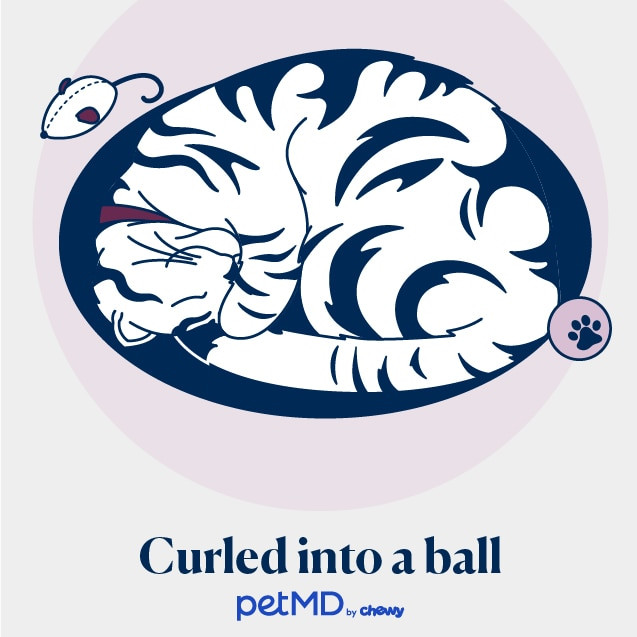 Cat sleeping curled up in a ball to conserve warmth and protect vital organs
Cat sleeping curled up in a ball to conserve warmth and protect vital organs
One of the most frequently seen sleeping positions is the classic curl. Cats often sleep curled up in a ball, tucking their nose towards their tail. This position is a masterclass in heat conservation, helping them minimize heat loss and stay warm, which is particularly beneficial in cooler environments. Beyond warmth, curling up also serves a protective function. This posture shields their vulnerable abdominal organs, encasing them within layers of muscle and bone for added security. It’s a perfect blend of comfort and instinctual self-preservation.
2. On Their Back
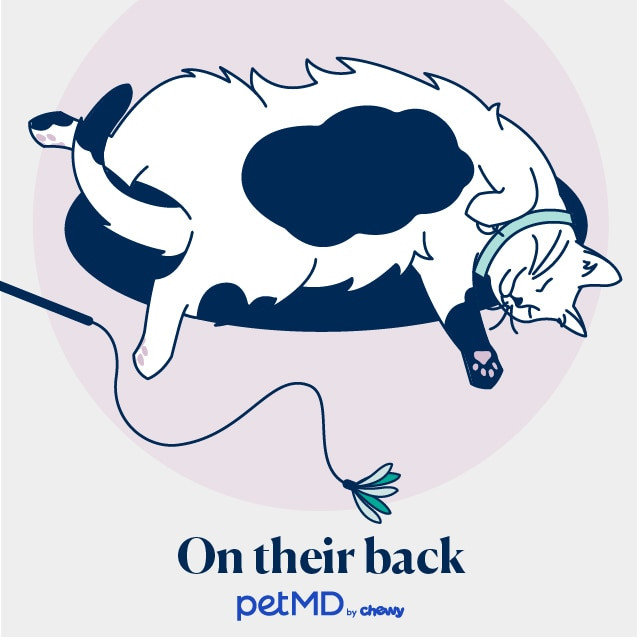 Cat sleeping on their back, belly exposed indicating feelings of safety and security
Cat sleeping on their back, belly exposed indicating feelings of safety and security
Witnessing your cat sleeping on their back, with their belly fully exposed, is a sign of ultimate trust and relaxation. Whether their front paws are resting gently on their stomach or stretched out above their head, this vulnerable posture speaks volumes about their comfort level in their environment. Cats instinctively protect their vital organs, so exposing their abdomen is a clear indicator that they feel exceptionally safe and secure in their surroundings.
Despite this display of trust, it’s generally advisable to resist the urge to rub their exposed belly. Even in this relaxed state, most cats retain their instinct to protect themselves if their belly is touched, and they might react with a nip, swat, or scratch. Admire the vulnerability, but respect their personal space.
3. Side Sleeping
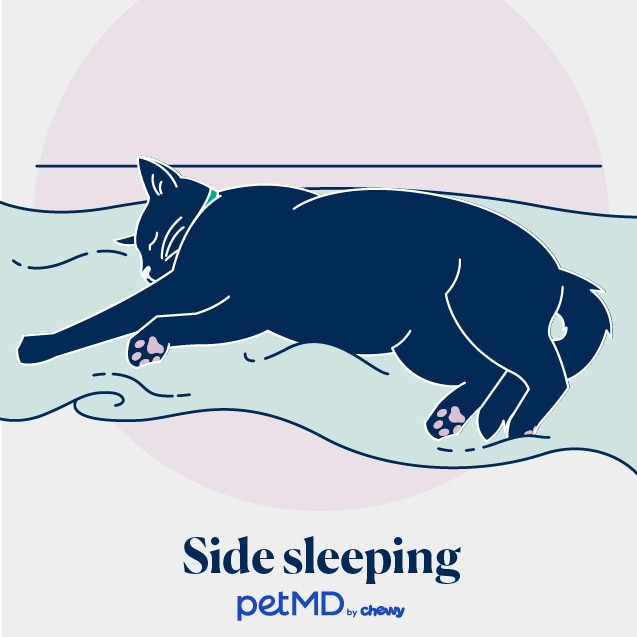 Cat sleeping on their side, a comfortable yet alert position for quick escapes
Cat sleeping on their side, a comfortable yet alert position for quick escapes
Sleeping on their side, with legs extended, is another common and comfortable position for cats. Similar to the back-sleeping posture, side sleeping reveals a level of comfort and trust, as their vital organs are somewhat exposed. It signifies that your cat feels secure enough to relax and let down their guard around you.
However, side sleeping offers a practical advantage. It allows for quicker responses if needed. As natural prey animals, cats maintain a degree of alertness even in sleep. This position enables them to spring up and move swiftly if they sense any potential threat, providing a sense of security while still allowing for restful sleep.
4. In a Loaf Shape
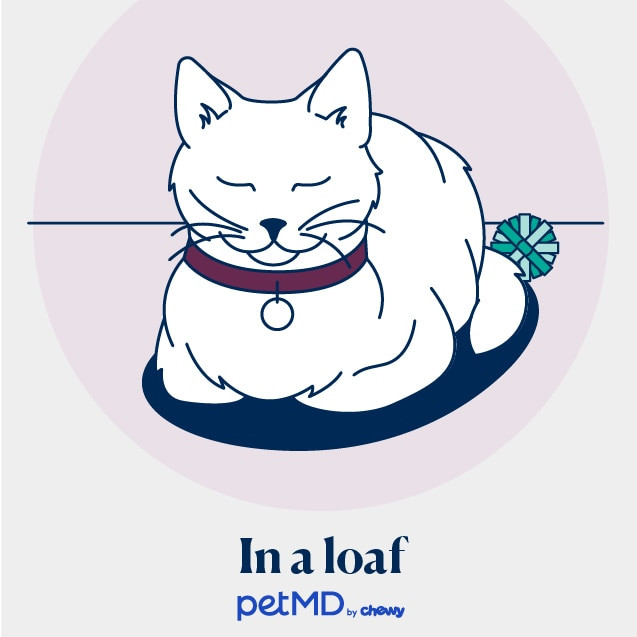 Cat sleeping in a loaf position, relaxed but ready to react quickly
Cat sleeping in a loaf position, relaxed but ready to react quickly
The “loaf” position, resembling a neatly tucked loaf of bread, is a classic cat pose. When in loaf form, cats keep their front paws tucked under their body, with their head held upright. This posture effectively conserves body heat and shields their vital organs, offering both warmth and protection.
Cats in a loaf position might appear completely relaxed, but they are often in a state of relaxed alertness. They can quickly transition to action if they perceive danger, ready to use their claws and escape if necessary. This position is a testament to their ever-present awareness, even in moments of apparent rest.
5. The Superman Pose
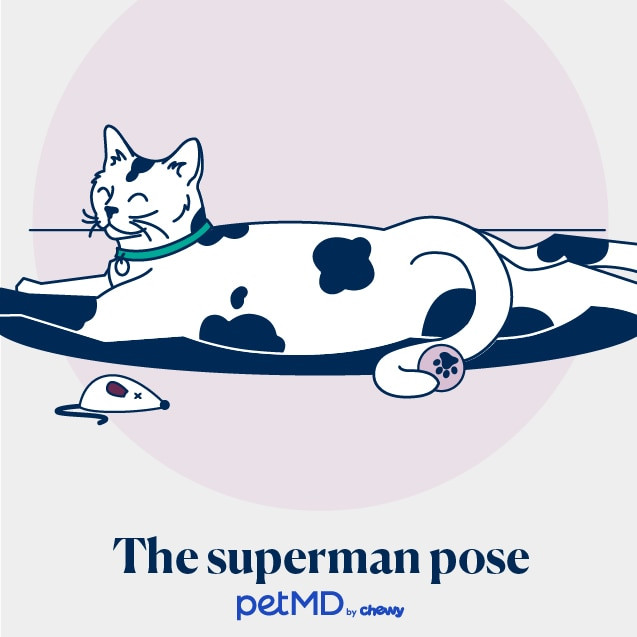 Cat sleeping in the Superman pose, relaxed yet prepared for action
Cat sleeping in the Superman pose, relaxed yet prepared for action
The Superman pose is both adorable and indicative of a relaxed cat. In this position, the cat lies flat on their belly with front legs stretched forward and back legs stretched behind, mimicking Superman in flight. It’s a sign of relaxation, but don’t be fooled – they are still prepared.
While seemingly sprawled out, all four paws remain extended and ready for action. This position also offers the benefit of protecting their vulnerable belly against the surface they are lying on. Lounging in a Superman pose on a warm surface like a fuzzy blanket can help conserve body heat in cooler temperatures. Conversely, on a hot day, they might choose a cool tile or hardwood floor in this pose to dissipate heat and cool down.
6. Perched on Furniture or Appliances
 Cat sleeping perched on the back of a couch, seeking vantage points for safety and observation
Cat sleeping perched on the back of a couch, seeking vantage points for safety and observation
Finding your cat asleep perched precariously on the back of the couch, the arm of a chair, or even atop the refrigerator might seem risky, but it’s a strategically advantageous sleeping spot for them. This elevated position offers several benefits rooted in their instincts.
Firstly, a high vantage point provides a sense of safety from potential threats while they sleep. In a domestic setting, “threats” might include other pets, children, or unfamiliar visitors. Secondly, as natural predators, a perched position provides a panoramic view of their territory, allowing them to keep an eye out for potential prey. While household “prey” is more likely to be cat toys than mice, the instinct to observe and survey remains strong. Consider providing a cat tree with a high perch as a safe and designated alternative to your furniture, satisfying their need for elevated snoozing spots.
7. In Strange Positions
 Cat sleeping in a strange and contorted position, showcasing their flexibility
Cat sleeping in a strange and contorted position, showcasing their flexibility
Cats are renowned for their ability to contort themselves into seemingly impossible sleeping positions. They might appear to be in incredibly uncomfortable postures, but thanks to their exceptional flexibility, what looks awkward to us is likely perfectly comfortable for them.
The secret lies in their anatomy. A cat’s spinal column has highly elastic discs, allowing for remarkable twisting and bending. Additionally, their shoulder blades are loosely attached by muscle rather than bone, granting an extraordinary range of motion in their shoulder joints. This unique flexibility enables them to adopt a wide array of strange and wonderful sleeping positions.
8. Sitting Upright
 Cat sleeping while sitting up, a confident and easy-grooming posture
Cat sleeping while sitting up, a confident and easy-grooming posture
When a cat sleeps in a sitting position, resembling a human posture, it’s often a sign of confidence and security in their environment. By sitting upright, they expose their belly, signaling that they feel safe and unthreatened.
Beyond security, sitting upright also provides convenient access for grooming. This position makes it easier for them to groom their belly with minimal effort between naps. Some cats might also adopt this posture to provide support for their back muscles, offering a different kind of comfort.
9. On Your Chest
 Cat sleeping on a human's chest, seeking closeness, comfort, and warmth
Cat sleeping on a human's chest, seeking closeness, comfort, and warmth
There are numerous heartwarming reasons why your cat might choose to sleep on your chest. If your cat is strongly bonded to you, sleeping on your chest is a clear indication of their desire for closeness and affection. They simply want to be near you, enjoying your company and warmth.
Additionally, they might be drawn to the sound of your voice and breath. Just as a baby is soothed by a heartbeat, the rhythmic sound of your heart and breathing can be deeply comforting to your cat. Sleeping on your chest also provides a direct source of your body heat, making it a cozy and secure sleeping spot.
10. Next to You
 Cat sleeping next to a human, showing trust while maintaining personal space
Cat sleeping next to a human, showing trust while maintaining personal space
Choosing to sleep next to you rather than directly on you doesn’t indicate a lack of affection. In fact, sleeping beside you is also a sign of trust, showing they feel safe enough to be vulnerable while sleeping in your vicinity.
Some cats prefer a bit of personal space, even when bonded to their humans. Sleeping next to you provides a sense of connection and security while maintaining a comfortable buffer zone. It’s their way of expressing closeness while still maintaining a degree of independence.
11. On Your Head
 Cat sleeping on a person's head, seeking warmth, comfort, and undisturbed rest
Cat sleeping on a person's head, seeking warmth, comfort, and undisturbed rest
Finding your cat nestled on your head while you sleep can be a unique experience. One primary reason for this behavior is simply the quest for a soft and comfortable napping spot. Your head, resting on a pillow, offers a plush and inviting surface. Furthermore, your head tends to move less during sleep compared to the rest of your body, providing a less disturbed resting place.
Cats are also creatures of habit and often adapt to their owners’ sleep schedules. If you’re sleeping, your cat might simply want to be near you and join you in rest. Sleeping by your head also offers easy access to you. From this vantage point, they can easily reach out and wake you up if they need food, attention, or anything else.
12. On Your Feet
 Cat sleeping on a person's feet, seeking warmth and a secure escape route
Cat sleeping on a person's feet, seeking warmth and a secure escape route
When a cat sleeps at your feet, they are often providing you with a furry foot warmer, but they are also seeking warmth for themselves. Sleeping on or by your feet allows them to be close to you while maintaining a sense of security.
The foot of the bed, couch, or chair offers an easily accessible escape route if needed. This position balances their need for proximity with their instinct for safety, allowing them to feel close yet secure.
13. Between Your Legs
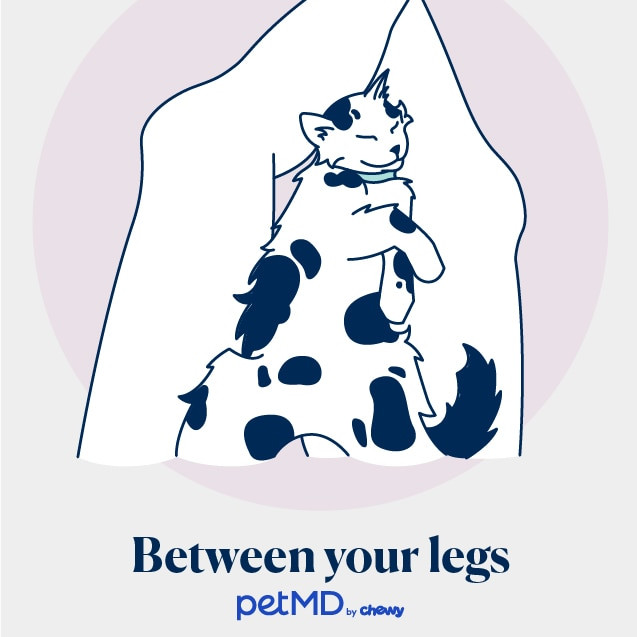 Cat sleeping between a person's legs, creating a warm, safe, and nest-like space
Cat sleeping between a person's legs, creating a warm, safe, and nest-like space
While it might be slightly inconvenient for you, sleeping between your legs can be quite appealing to your cat. This position allows them to be incredibly close to you, enveloped by the warmth of your legs. Your legs create a cozy, safe, and nest-like area, providing a sense of security and comfort.
Despite being nestled between your legs, they still maintain a sense of security with an easy escape route available at either end. It’s a snug and secure sleeping position that caters to their need for both closeness and safety.
14. In a Box
 Cat sleeping in a box, finding security and comfort in enclosed spaces
Cat sleeping in a box, finding security and comfort in enclosed spaces
A cat’s love for boxes is legendary, and it’s deeply rooted in their instinct as prey animals. Boxes provide a sense of security and enclosure, offering a safe haven where they can retreat and feel protected from perceived threats. This is why cats are often drawn to empty cardboard boxes, instinctively seeking out enclosed spaces.
Boxes offer warmth and security, much like a camping tent does for humans. They provide a defined, safe space with easy exits, just in case. When cats attempt to squeeze into boxes that seem too small, they are often seeking that intense feeling of security, similar to the comfort a baby feels when swaddled.
15. In the Litter Box
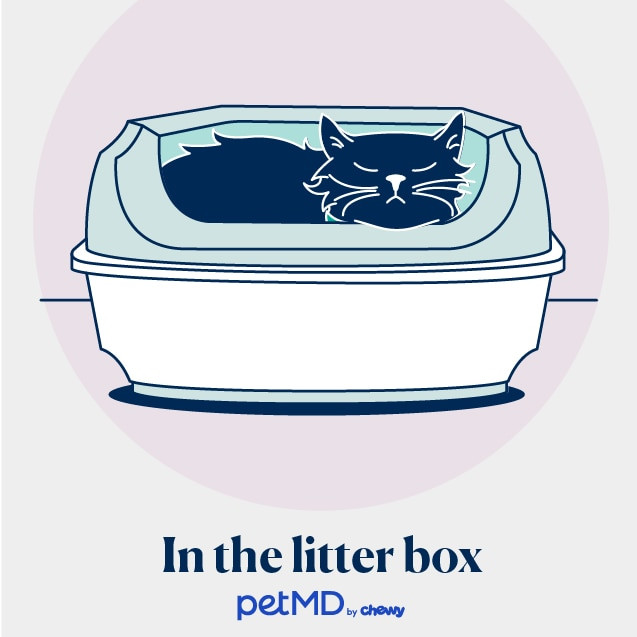 Cat sleeping in a litter box, a potential sign of medical issues requiring veterinary attention
Cat sleeping in a litter box, a potential sign of medical issues requiring veterinary attention
If you find your cat sleeping or frequently lying in their litter box, it’s crucial to recognize this as a potential sign of a medical issue, especially urinary or digestive problems. If your cat starts exhibiting this behavior, it’s essential to contact your veterinarian immediately. Sleeping in the litter box can indicate a sudden change in your cat’s health and should not be ignored.
While in rare cases, a cat might simply develop a peculiar preference for the litter box, or it might occur in stressful environments like animal shelters where safe sleeping spaces are limited, it’s always best to rule out any underlying medical causes first. Veterinary consultation is paramount to ensure your cat’s well-being.
16. Eyes Open or Half Open
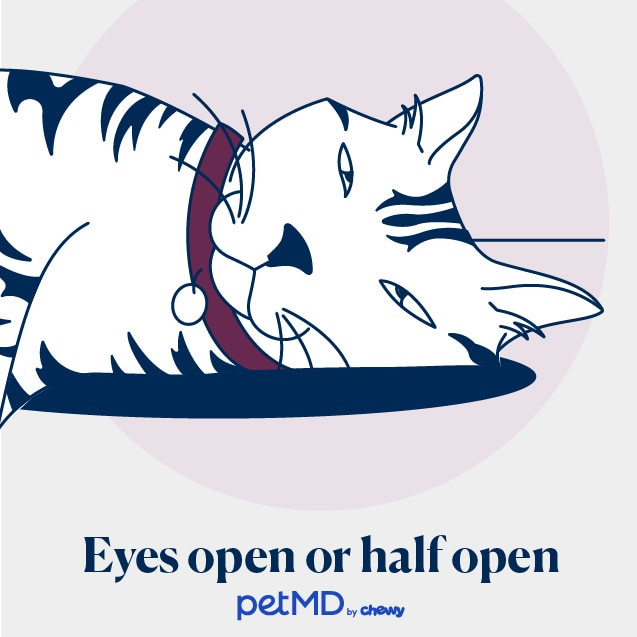 Cat sleeping with their eyes open, a state of light sleep with vigilance maintained
Cat sleeping with their eyes open, a state of light sleep with vigilance maintained
Cats have the fascinating ability to sleep with their eyes fully or partially open. Sometimes, you can even observe rapid eye movement (REM) sleep through their slightly opened eyes, the sleep stage where dreams likely occur in cats, just like in humans.
Cats possess a translucent third eyelid, located beneath their other eyelids, which can be visible when they are sleeping. This third eyelid provides protection to the eye from irritants and prevents dryness during sleep.
While sleeping with eyes open can be normal for some cats, it’s important to be vigilant for any underlying medical reasons. If you observe any eye problems such as swelling, discharge, squinting, pawing at the eye, or if the third eyelid is consistently visible even when your cat is awake, it’s important to consult your veterinarian promptly.
17. Paws Over Eyes
 Cat sleeping with paws over their eyes, blocking out light and providing warmth
Cat sleeping with paws over their eyes, blocking out light and providing warmth
It’s undeniably adorable when a cat sleeps with their paws covering their eyes, but this behavior serves practical purposes. Using their paws as a makeshift eye mask is quite functional.
Paws placed over the face can provide insulation and warmth for both the paws and the face, acting like cozy mittens. Additionally, their paws function as natural sleeping masks, effectively blocking out harsh light or even airborne irritants like dust or pollen, creating a darker and more comfortable sleep environment.
18. With Other Cats
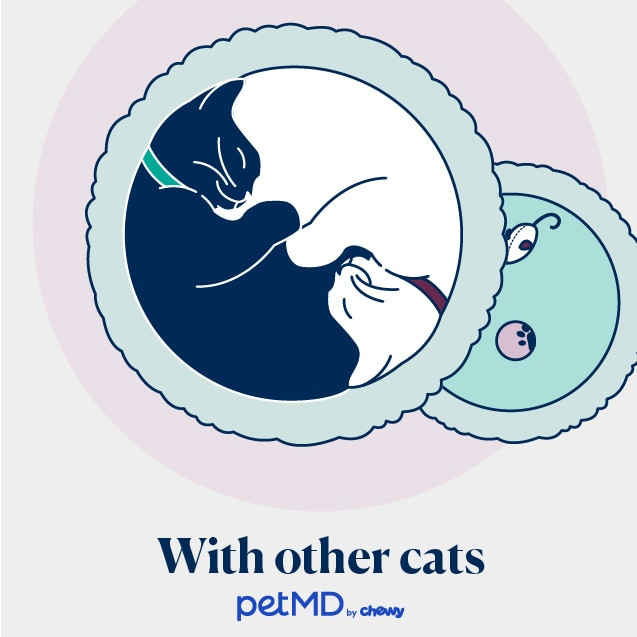 Two cats sleeping together in a cat bed, showing companionship and shared warmth
Two cats sleeping together in a cat bed, showing companionship and shared warmth
While some cats in multi-cat households might merely tolerate each other’s presence, many cats genuinely enjoy the company of their feline housemates and will often choose to sleep together.
Sometimes, this simply involves sharing a comfortable bed, but often, cats sleep together because they have formed bonds and enjoy companionship. Sleeping in a group provides shared warmth, enhancing comfort and security. Furthermore, cats sleeping together might be soothed by the gentle sound of another cat’s purr, creating a calming and relaxing sleep environment.
19. With a Dog
 Cat sleeping next to a dog, indicating interspecies bonding and mutual comfort
Cat sleeping next to a dog, indicating interspecies bonding and mutual comfort
Although cats and dogs are not natural allies, and sometimes exhibit a predator/prey dynamic, they can, with careful introduction and socialization, form strong bonds. Gradual and supervised introductions are key to fostering positive relationships between cats and dogs.
In homes where cats and dogs have formed a close bond, they may choose to sleep together for companionship, warmth, and mutual comfort. These interspecies friendships can lead to heartwarming displays of affection and shared rest.
20. Tucked In
 Cat sleeping tucked under a blanket, seeking warmth, security, and a quiet space
Cat sleeping tucked under a blanket, seeking warmth, security, and a quiet space
If your cat enjoys sleeping under the covers, they are likely relishing the warmth and the comforting sense of security it provides. The enclosed space under blankets offers a sense of safety and den-like comfort. They also enjoy the familiar and comforting scent of their human within the bedding.
Cats are often sensitive to noise, and being tucked under covers can create a quieter and more sheltered environment, minimizing stressful sounds. Some cats simply appreciate the feeling of being wrapped or swaddled in a blanket, finding it inherently soothing.
While generally safe, it’s always important to be mindful of your cat’s location when they are under blankets or sheets to prevent accidental injury. Ensure the material they are under is breathable for their safety and comfort.
